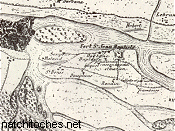The body of water known as Cane River Lake is the very heart and soul of our home, the area now called Cane River Country. As most things here, it too, has a fascinating story. It began as the Red River itself, and was the head of navigable water on the Mississippi/Red River route even before the first French explorers entered the area, and remained so for many years.
 Early navigation above Natchitoches, was impeded by a 160-mile (260-kilometre) log jam known as the Great Raft. It was here at the opening of navigable water, that French Canadian explorer Louis Juchereau de St.Denis found a long established settlement of the Natchitoches Indians and so began his trade among them. The French later built Ft. St.Jean Baptiste on the river’s western banks to protect the interior territory from Spanish encroachment from the west.
Early navigation above Natchitoches, was impeded by a 160-mile (260-kilometre) log jam known as the Great Raft. It was here at the opening of navigable water, that French Canadian explorer Louis Juchereau de St.Denis found a long established settlement of the Natchitoches Indians and so began his trade among them. The French later built Ft. St.Jean Baptiste on the river’s western banks to protect the interior territory from Spanish encroachment from the west.
 In the 1830s Henry Miller Shreve created the first snag boats to clear the Raft. Soon after the raft was cleared, the fickle river began to change the course of it’s main channel. The result was a new channel which cut across a bend over four miles north of Natchitoches at Grand Ecore.
In the 1830s Henry Miller Shreve created the first snag boats to clear the Raft. Soon after the raft was cleared, the fickle river began to change the course of it’s main channel. The result was a new channel which cut across a bend over four miles north of Natchitoches at Grand Ecore.
Afterwards, steamboat access to the town of Natchitoches became only sporatic and finally, impossible. The city’s loss became Grand Ecore’s gain, with the latter growing into a significant settlement.
As the new channel became deeper, the route through Natchitoches became less and less navigable, and by the beginning of the 20th century, dams were built to separate the old channel from the new. “Cane River Lake” was separated from Red River.
 Today, Cane River Lake is a beautiful, meandering body of water, a lake, but one having the characteristics of a stream. Although about 32 miles in length, the lake averages only 250 feet in width, giving it a surface of less than 1,000 acres.
Today, Cane River Lake is a beautiful, meandering body of water, a lake, but one having the characteristics of a stream. Although about 32 miles in length, the lake averages only 250 feet in width, giving it a surface of less than 1,000 acres.
It is an asset without which Natchitoches and the surrounding area could not survive as such a desirable place in which to work, play and live.
